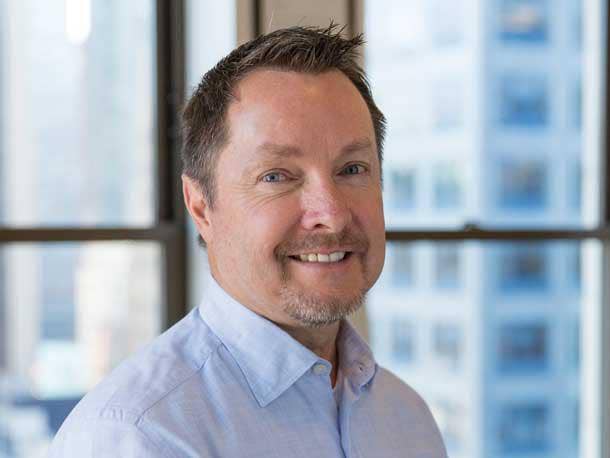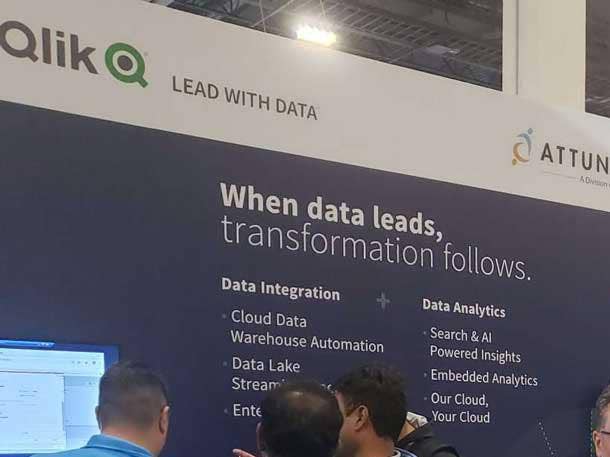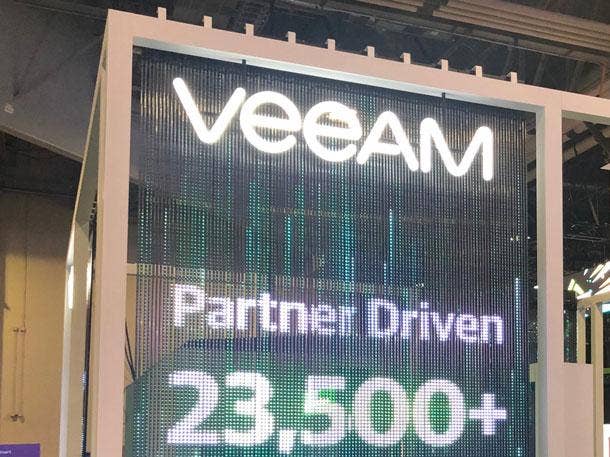New Veeam CMO: ‘We Are A Strong Enterprise Player’
‘Veeam built itself initially around SMBs and small to midsize enterprises. Our competitors would have you believe that Veeam’s an SMB company. Yes, we are incredibly strong there. But we’ve got well over 300,000 active customers, of which a significant amount are Fortune 500 or Global 2000 companies. … We want to have a strong enterprise selling motion, really building out strategies with our large customers [with] strategic backup and recovery frameworks,’ says Veeam CMO Rick Jackson.

Plans To Grow Veeam’s Footprint In The Enterprise
Data protection technology developer Veeam works with channel partners who deal with clients ranging from small companies to the Fortune 500. However, according to Rick Jackson, Veeam’s new chief marketing officer, the Columbus, Ohio-based company is still perceived as an SMB-focused company. It is a perception Jackson is determined to change.
“I think we are a strong enterprise player,” he told CRN. “We just haven’t positioned the company that way. We’re not selling that way. We just got to make some changes there.”
Jackson joined Veeam in July, but he and the company have kept his arrival quiet until now. Jackson previously held the chief marketing officer roles at Qlik, Rackspace, VMware, and Borland. He took over the Veeam CMO position from Jim Kruger, who left Veeam in January to take the executive vice president and CMO post at Informatica, as well as from Tommy Jenkins, a three-year Veeam veteran who served as interim CMO before leaving the company in July to become the CMO at Vectra AI.
[Related: Object First Exits Stealth, Focuses Exclusively On Veeam Environments]
In addition to helping channel partners and their customers overcome any hesitation to bringing Veeam’s technology to the enterprise, Jackson is also helping spearhead efforts to get the industry to focus on the recovery part of backup and recovery. “You really need an orchestrated plan for how to recover across everything,” he said. “We’ve got to get the channel to better understand that and help them communicate that message.”
There’s a lot going on at Veeam, including the news that the company now is likely the IT industry’s number-one provider of data protection technology. For a look at what’s happening, read on.

You joined Veeam after some time at Qlik. What did you do there?
I spent the last eight years at Qlik, which is focused on business intelligence. Basically we took a company that when I joined was public, and we went private, with a PE [private equity] firm called Thoma Bravo, and re-architected the business, moving into SaaS, getting all the right things done. And we were actually preparing to take it public again this year. But unfortunately, the markets changed dramatically.
Why did you leave before the finishing the Qlik IPO?
Well, the way everything changed, it was going to be a while for the IPO. And quite honestly, being a CMO at a company for eight years, that’s a long time. And I like fresh and new challenges and thinking about new things. I had the opportunity to move over to another company that I think has really good prospects for a potential IPO. Which would be Veeam.

So why Veeam? What is it about Veeam that attracted you to join?
First and foremost, I look at culture and the people that I work with. I’ve been very fortunate in my career. I’ve had a lot of success. And what I found is, day to day, I want to be happy and excited about what I do. I was impressed with the leadership that Veeam brought in. We have a fairly new CEO, fairly new COO, a very new CRO, who’s my partner. And now myself. And the interesting thing about the executives that have been brought in, these are guys that have ‘been there done that.’ Super professional, smart, very strategic thinkers. And this was the group of executives that I knew I’d be excited to be working alongside. Veeam has a great reputation internally for its culture. ...
I’m a big believer that data is by far the most important asset that every single business has. You use the data correctly, you’ll thrive. Use it incorrectly, you won’t. But you got to have it, you got to make sure it’s always there. And so this backup and recovery and data protection market is critical. And it’s only becoming more critical. We keep expanding the workloads and data. So there’s just going be incredible need and demand for the types of solutions Veeam is providing. I like the fact that Veeam is the market leader. We announced early this year that we were effectively tied for global leadership, the number one market position globally. In terms of market share, we have outgrown and outpaced our competitor by well over 3X. So very soon, there will be a report that comes out that shows that Veeam is the definitive number-one worldwide market leader in backup and recovery.
Which competitor was that, by the way?
The one we were tied with was Dell EMC, and we’ve surpassed them. So great position, growing company, good solutions. The customer NPS [net promoter score] here was off the charts, and that’s a good sign. But there’s work to be done. And so I saw, what a great starting point, leadership position, outgrowing the market significantly, outgrowing its competitors, happy customers, happy employees, with an opportunity to really expand our strategy and what we’re doing in the enterprise market. … It was just too good a fit for me not to take advantage of it.

You said there’s work to be done. What are some of the things you want to do?
Veeam built itself initially around SMBs and small to midsize enterprises. Our competitors would have you believe that Veeam’s an SMB company. Yes, we are incredibly strong there. But we’ve got well over 300,000 active customers, of which a significant amount are Fortune 500 or Global 2000 companies. So we’ve done very well all up and down the chain. Our selling motion has been more transactional, which is what you’d expect coming out of the SMB business. It’s exactly what I experienced going into VMware. We want to have a strong enterprise selling motion, really building out strategies with our large customers and building out strategic backup and recovery frameworks with those customers. And so elevating our position as more of a strategic partner, partnering with the enterprise, growing the footprint in the enterprise, etc.
Veeam has an incredible transactional engine, one of the best I’ve ever seen. But we need to layer in and add more of that enterprise focus and that enterprise sales motion, and market that way. That’s something that our new CRO John Jester and myself are really going to team up on, and we have a lot of good ideas we’re starting to work through. But I think we are a strong enterprise player. We just haven’t positioned the company that way. We’re not selling that way. We just got to make some changes there. And it’s the same thing I saw at VMware. VMware was a major enterprise company that didn’t sell and act like an enterprise company. We changed that, and we’ll change it here.
Is that push to the enterprise still channel-focused for Veeam? Or is there a direct focus as well?
Veeam was built on channel partners, and will continue to embrace the channel. I think it means expanding the channel a bit. So we’re looking at how to do it. We are working more with GSIs [global system integrators], for example, that have incredible influence in the enterprise. That has always been a focus of the company. Certainly, with some of the technology alliances, we’re having some good conversations with them.
So no, we won’t disintermediate the channel. The channel is still there. But even in a channel model, your sellers are on their side. Whether we’re co-selling with the channel, or referring our partners to certain opportunities, we also have to build more of a relationship with the enterprise and get involved while expanding the type of channel that we’re relying on for the enterprise segment.

So going forward, Veeam will still remain 100-percent channel focused, right?
As of right now, there’s no change in that strategy. I couldn’t say if we were going to change it or not, because we haven’t gotten that far along in determining how we’re going to do this. But as of right now, we’re 100-percent channel and no change at the moment.
As Veeam does more with the enterprise market, does it have to change its technology to meet that market, or will it be the same technology Veeam brings to its SMB customers?
That question is exactly my challenge as a CMO, because there’s a feeling of, well, if you grew up through SMB, your technology only works for SMB. We have some of the biggest companies in the world running Veeam at scale. We’ve proven we can take our technology into large enterprises. We just have to do a better job of communicating that. We’re always improving our technology. We’ve got some incredible changes in our next major release of Veeam Disaster Recovery 12 that is coming down the pipe. A lot of those changes, a lot of the enhancements in that platform, are designed to help enterprises in particular and help create a much more cost-effective scale-out strategy for backup in the cloud in particular.

In your role as chief marketing officer, what are some of the things you need to focus on from the marketing perspective in order to help your channel partners.
We’re looking at how we do our messaging and positioning. We want to be the standard for backup and recovery. What I’m seeing in some cases is, our channel is focused on very specific types of backup and recovery and very specific types of workloads. A lot of our channel partners are very focused on virtualization and virtual workloads. But the reality is, the whole point of backup and recovery is recovery. And if it’s about recovery, then you really want a more holistic, unified approach to how you can recover, especially from a disaster or a cyber threat or ransomware or what have you. That you can act quickly and efficiently and reliably across your entire business.
This market is peppered with multiple solutions. On average, every business has 3.5 backup vendors. That’s got to change. That’s not conducive to a strong recovery strategy. It may work for optimizing backup strategies for everything. But when it comes time to recover, you don’t want to be in four different environments and try to figure out who’s doing what. You really need an orchestrated plan for how to recover across everything. We’ve got to get the channel to better understand that and help them communicate that message.

How does your marketing experience with VMware, which is focused on virtualization and the cloud, and Qlik, which is focused on data analytics, help you with Veeam?
In both cases, I entered a company that was transactional-based and selling very small, targeted solutions. And in both cases, we recognized the need to get much stronger at selling to the enterprise to become more of an enterprise platform. At VMware, it was continuing to expand the technology we already had. But really, it was about better messaging, better positioning, sales enablement, channel enablement, and getting the market to think of us as more than virtualization. And that’s where we started the journey to the cloud and cloud infrastructure, etc. At Qlik, we basically built a strategy which they called active intelligence. Then we did two years of M&A to build against that strategy, and then repositioned the company as more of an end-to-end data integration and analytics and automation platform. It was a lot of acquisitions, re-architecting, moving it all to the cloud, and then repositioning the company.
[Veeam has] a platform that covers SaaS, cloud native workloads, on-premises, physical servers, virtual workloads. So we have a lot of the elements. We just need to package it a little bit better together and then position ourselves more appropriately that way. And then have to drive more awareness around the fact that we are very successful as an enterprise player in the market. So expect to see a lot of investment in awareness next year for the company.
So it’s kind of similar in terms of what needs to be done. It’s just every company I’ve been at has a slightly different starting point and therefore dictates a slightly different set of priorities. But I like what we’ve got to work with here. I think there’s low hanging fruit we can take advantage of that we’re starting to look at right now. But a lot of this is just positioning and driving awareness around what it is we do and how we do it.